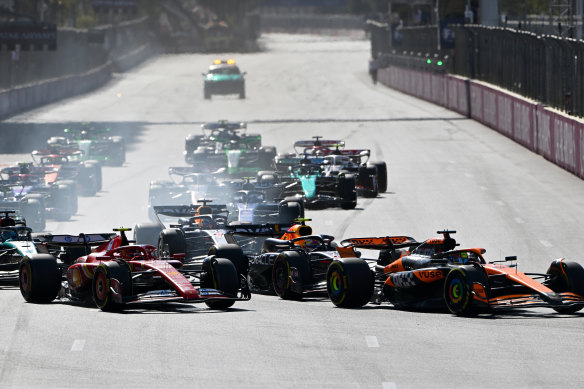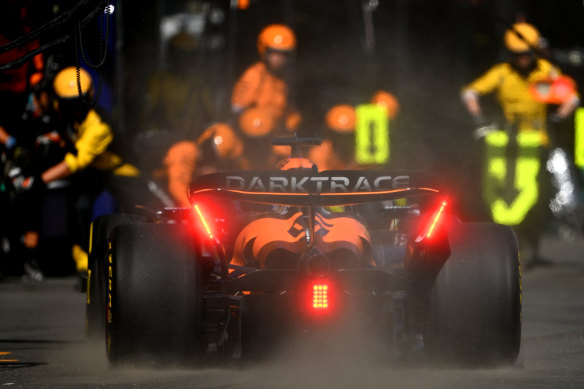This was published 5 months ago
‘Hung on for dear life’: The anatomy of Piastri’s killer move
Nothing in life is perfect, but what Oscar Piastri delivered in Baku on the shores of the Caspian Sea late on Sunday night (AEST) was as close as possible to it in a sporting sense.
We break down how the 23-year-old from bayside Melbourne had the sporting world on the edge of its seat, including the killer move that won the Azerbaijan Grand Prix for him.
The start
Starting from second on the grid next to Ferrari star Charles Leclerc, Piastri’s mission was simple – get a clean start off the line, and avoid any potential carnage involving cars around him into the opening turn. He did.

Piastri (far right) trailed only race leader Charles Leclerc into turn one, with the Red Bull of Sergio Perez and Ferrari’s Carlos Sainz hot on his tail.Credit: Getty Images
He didn’t have to lead Leclerc out of turn one, but he had to be within striking distance.
Otherwise, it would be just a matter of time before he built up a gap of more than a second.
Leclerc got a strong start – despite Piastri starting on his inside heading into the opening bend, a slow left-hander.
Sergio Perez locked up his tyres braking his Red Bull into turn one, but Piastri was unscathed.
The pit stop
On a fast circuit like Baku, drivers typically only need to pit once for tyres. Most of the 20-car field will start on medium tyres (giving them the best combination of immediate grip and durability), but Piastri’s teammate, Lando Norris, opted for hard tyres because he was starting from further back, and could use the mediums for the sprint to the finish.

Piastri making his pit-stop.Credit: Getty Images
Why is this so important? Piastri stopped on lap 15 of the 51-lap race – going from medium to hard tyres – but he was at risk of falling back into the clutches of a trailing Perez when he rejoined the race. Norris helped Piastri by keeping the cars behind him at bay. Every second he could stave off Perez meant Piastri stood a better chance of cementing his position ahead.
The race-winning move
Staying in touch with Leclerc over the opening stages – particularly through the pit stops, most of which took place between laps 15 and 20 – was crucial if Piastri was to win his second grand prix.
The Baku home straight, where DRS moves are most effective, is an eye-popping 2.2 kilometres long. It’s by far the longest of any track on the F1 calendar and allows for astonishing overtaking moves, often under braking, at turn one after the cars have reached speeds nudging 360 km/h.
While trailing cars can use the slipstream of the car in front (copying their driving line so the lead car cuts through the air, creating a pocket for the car behind to sit in), it’s the drag reduction system that is the real key here.
By opening their rear wing while sitting less than a second behind the car in front, the trailing car – in this case Piastri’s – can close down a seemingly insurmountable gap in no time.
But with the unforgiving concrete walls surrounding the track, and the first corner rapidly approaching, would they be willing to try?
As powerful as an F1 car’s braking is, it’s still no match for a concrete wall.
With Piastri within a second of Leclerc on lap 19, he knew this was now or never – stand up, or stand down.
The unflappable young gun has a seemingly robot-like quality behind the wheel – all the best drivers do. He’s not ruled by emotion, and he doesn’t second-guess himself. When he sees an opportunity, he takes it.
Roaring down the straight to cross the start-finish line to begin lap 20, Piastri closed at breakneck speed.
As Leclerc took the preferred racing line – the quickest route through any corner – heading into turn one, Piastri darted down the inside. He took all the risk, for potentially all the reward.
How brave was he feeling on the brakes?
“I tried at the start of the race to get in front, but once I dropped out of DRS [range] I just didn’t have the pace, and after the stop, I saw we were pretty close again, and I felt like we had a little bit of extra grip, and I had to go for it because I knew that if I didn’t get past at the start of the stint, I was never going to get past,” Piastri told the Sky F1 coverage after the race.
“I went for a pretty big lunge but managed to pull it up and then hung on for dear life.”
But the overtake wasn’t all Piastri had to worry about. He had to consolidate the move, with the red-hot Leclerc right on his heels, and stay there for the remaining 31 laps.
Making it count
Leclerc would later admit that he “lost the race” by not defending as well as he should have on lap 20, but he pushed Piastri to within just tenths of a second before the Australian finally broke clear.
Lap after lap, the pair navigated Baku’s 20 turns in what seemed like perfect synchronicity. When one ran wide, the rear of his car sliding out from underneath him as his tyre grip faded, the other did the same.
For every question Leclerc posed in the second half of the grand prix – until the huge crash between Carlos Sainz jnr and Sergio Perez in the closing stages forced the race to end under a “virtual safety car” – Piastri had an answer. Every time Leclerc tried to overtake down the same straight that Piastri claimed the lead on, Piastri shut the move down.
Leclerc had all the advantages that Piastri had earlier – DRS, slip-streaming, you name it – and did so for far longer, but Piastri’s nerves of steel were unflinching.
For nearly 30 laps, he was faultless – perfect, even.
“He’s no longer the next big star – this star has well and truly arrived,” said former F1 racer Karun Chandhok on the Sky coverage in analysing the race.
“There can be no doubt in anybody’s mind that Oscar Piastri deserved that victory today.
“Perfect, perfect drive.”
2024 AZERBAIJAN GRAND PRIX FINISHING ORDER
- Oscar Piastri (McLaren) 1:32:58.007
- Charles Leclerc (Ferrari) +10.910 sec
- George Russell (Mercedes) +31.328
- Lando Norris (McLaren) +36.143
- Max Verstappen (Red Bull) +77.098
- Fernando Alonso (Aston Martin) +85.468
- Alex Albon (Williams) +87.396
- Franco Colapinto (Williams) +89.541
- Lewis Hamilton (Mercedes) +92.401
- Oliver Bearman (Haas) +93.127
- Nico Hulkenberg (Haas) +93.465
- Pierre Gasly (Alpine) +117.189
- Daniel Ricciardo (RB) +146.907
- Zhou Guanyu (Sauber) +148.841
- Esteban Ocon (Alpine) +1 lap
- Valtteri Bottas (Sauber) +1 lap
- Carlos Sainz jnr (Ferrari) DNF
- Sergio Perez (Red Bull) DNF
- Lance Stroll (Aston Martin) DNF
- Yuki Tsunoda (RB) DNF
News, results and expert analysis from the weekend of sport are sent every Monday. Sign up for our Sport newsletter.